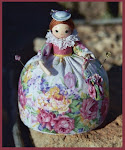
When my daughter was young we read, several times!, a wonderful book called Miss Hickory by Carolyn Sherwin Bailey. It was a Newberry award winner in the late 1940's, I think. The story is about an independent minded little doll, made from a hickory nut and applewood twig, who must fend for herself when the dollmaker and her family leave cold New Hampshire and go 'south' to Boston for the winter. Though she is independent and feisty, Miss Hickory learns to gracefully accept help from crow, squirrel, cat and other friends.
It took me 35+ years, but at long last I have created a Miss Hickory Doll! I think she matches pretty well the charming book illustrations by Ruth Gannett and the spirit of the character portrayed by Carolyn Sherwin Bailey.
It took me 35+ years, but at long last I have created a Miss Hickory Doll! I think she matches pretty well the charming book illustrations by Ruth Gannett and the spirit of the character portrayed by Carolyn Sherwin Bailey.

In the next several posts I will give instructions for making your own Miss Hickory doll. But, you must read the story first!! That will surely influence your characterization of the doll.
Thanks to Salley Mavor for allowing me to present my version of a type of doll she has been making for many years. Salley has illustrated several children's book with her "stumpwork" fabric art, as well as presenting patterns and instructions for her charming little "Wee Folk" dolls.









 Run a gathering thread at the waist near the edge (approximately 1/8”). Pull up thread, fit slightly below dolls waist, and tie off. Add a little glue there to hold in place. Let dry. Add a second layer of petals in the same way, this time at waist level.
Run a gathering thread at the waist near the edge (approximately 1/8”). Pull up thread, fit slightly below dolls waist, and tie off. Add a little glue there to hold in place. Let dry. Add a second layer of petals in the same way, this time at waist level.




















